Print Dealers: where would I be without them
Intro
I owe my print collecting jones to Betty Duffy, who ran the Bethesda Art Gallery from 1975 to 1987. When I first walked into her gallery in 1980, I thought I found heaven. Her front and back exhibition spaces were the size of an average bedroom. But hanging on the walls and, better yet, stored in alphabetized black boxes was everything I ever imagined in great American prints from 1920 to 1960. Equal to her marvelous inventory was her first-hand knowledge of many of the represented printmakers. Her prices were fair, but her policy was strict. She never discounted her prints. By the time she closed the gallery, I was a confirmed print collector.
So this blog is in honor of Betty Duffy. Through her I came to realize that print collecting is a symbiotic relationship between dealer and collector. Without the former the latter would probably not exist. With this gratitude in mind, I’d like to introduce a few of the print dealers who have helped me since Betty. I met them most recently at the annual Capital Art Fair on April 6 in Rosslyn (a ugly nest of high-rises across from D.C.), VA.
I would like to thank Robert K. Newman, of The Old Print Shop in Georgetown and New York, not only for allowing me to photograph at the fair but for being largely responsible for reviving the fair. Before he took over a few years ago, the fair was on its last legs. It was down to about 10 dealers, many of whom opening griped about the show’s management. This time 26 dealers participated with a nice spectrum of print inventory, from old masters, contemporary prints, Oriental woodcuts and, yes, the type of prints I collect. Robert can be reached at: 212-683-3950 and rnewman@capitalartprintfair.com
Bill Carl
William P. Carl–Fine Prints
www.williampcarlfineprints.com
How long have you considered yourself a print dealer, and how did you get your start in the profession?
I sold my first print in 1976. I had been working in the Wiggin Print Room of the Boston Public Library while in grad school and started my career at Childs Gallery on Newbury Street in Boston in that year. I started my own business in 1983. My graduate degree is in Library Science and I had always thought about working in art related special collections.
Was print dealing your initial profession? If not, what were your earlier jobs or what college training did you have?
This is the only career I’ve ever known. I’ve worked on my own prints over the years (white-line woodcuts and drawing) and I’ve done some writing, but dealing in fine art has always been my “raison d’etre.” My love of books is also part of the equation.
Are you a collector yourself? Is it separate from the material you sell? Or did becoming a print dealer change or stop your collecting?
Most dealers are collectors of something. When we own things, we learn about them. Writing the check always sharpens the eye. I’ve got some contemporary prints and drawings around the house including works by Michael Mazur, Sidney Goodman, Jim Dine, Sigmund Abeles and others. I respond to artists who can draw. I deal in pre-1960 fine prints, so this material I consider separate. Even still, I make changes if something is not standing the test of time.
How many shows do you do a year? What percentage of your sales happen at shows? Via your website? Via mailings?
I do about 5-7 shows a year. There really aren’t that many “print fairs” but they are vital, especially the New York show in early November. It’s the World Series of our profession. I now have over 500 artists on my site and I add works on a weekly basis. It’s a big part of the business. Printed catalogues are pretty much a thing of the past due to postage and printing costs.
What are the ways that you obtain your inventory? If you handle estates or deal directly with artists, how did these situations occur?
I buy prints wherever I can find them. The U.S. is still my main source, but over the last twenty years I’ve expanded and now buy in Holland, Belgium, France, etc. I go where the art is, and my interests have expanded over the years. I work with only two living artists; Charles Donker (Dutch) and Jakob Demus (Austrian). The rest of the work is by deceased artists so they are definitely not making any more.
Can you give me a short anecdote or two about your life as a print dealer–for instance some incident with a collector or artist?
I sold a magnificent Rembrandt etching back in the mid 1980s for $ 150,000. The print was purchased in the 1940s for about $ 20 and kept in a closet most of the time since then. That print today is worth about $ 400,000.
I first visited Amsterdam in the mid 1980s. I visited a print gallery on Nieuwe Spiegelstraat and was amazed at the works I was seeing from the 1880-1940’s era. I was not familiar with most of the artists, but I immediately realized I was onto something. Clearly, the Dutch did not stop making prints when Rembrandt died, and my American audience was not aware of this fine work. I started buying based on quality and that was my main criterion. The same applied to the Belgian printmakers between the wars. I started by looking around galleries in Brussels and was finding some great things by artists previously unknown to me. I also began buying books on the subject and I began to meet private dealers who offered me some great things. I tracked down the estate of Samuel Jessurun de Mesquita, a Dutch artist, who was MC Escher’s best friend and teacher. His work proved to be very appealing to my American collectors. The process of buying for resale is certainly trial and error and this is especially true for modern Dutch and Belgian prints.
Dan Lienau
The Annex Galleries
www.annexgalleries.com
How long have you considered yourself a print dealer, and how did you get your start in the profession?
I have considered myself solely as a print dealer for about the last 30 years. I started as a framer of works on paper in Berkeley, CA, in 1968, framing for collectors and galleries. I moved up to Santa Rosa in 1970 but continued my framing relationships in San Francisco and Northern California. I always sold prints in the shop but the framing paid the bills. About 30 years ago it just became a time management problem. Instead of spending hours deciding on a wood finish and mat color it was much more practical to spend that time cataloging and selling the prints, nationally.
Was print dealing your initial profession? If not, what were your earlier jobs or what college training did you have?
As a youth I had numerous and diverse jobs. I studied sculpture at University of Wisconsin Madison, and the sculpture studios shared a smoking area with the printmaking department. It was here where I first got interested in printmaking. A purchase in 1963 of a Leonard Baskin and two Franz Marc woodcuts from Roten Galleries, (for whom I worked in the mid 1970s while continuing to operate the gallery) with time payments spread over one year reinforced my interest. The rest has been an insatiable curiosity, but I am far from an academic. My early failures in the working world set up my ability to make mistakes and learn from them, something I have found invaluable in the way I do business as a print dealer, a willingness to experiment and not be over concerned if it doesn’t work out immediately.
Are you a collector yourself? Is it separate from the material you sell? Or did becoming a print dealer change or stop your collecting?
Every time I am asked this question I answer that anything I haven’t sold is in my collection, If I die tomorrow that is what the auction house would probably advertise. I buy my inventory for myself, and that now numbers over 6,000 works. If they sell, I am happy; if they don’t, I really don’t mind. They still intrigue me, and I know that down the line I will find the other person who is interested–something the internet has made much more possible, with an international audience. The only pieces that don’t have a price are things that have been given to me personally as a gift.
How many shows do you do a year? What percentage of your sales happen at shows? Via your website? Via mailings?
We are now down to between 8 and 12 print fairs and art shows per year. I keep trying to cut back as I age and the shows get more expensive and generate less profit. We used to do monthly shows at the gallery but now only do about 4 a year. We do exhibitions on our website, which have been successful. I would say about 75% of our sales are from our website and 25% from shows, though most sales at the shows are to people who have been to the website. I would include mailings in this since most of them are cards for shows and e-mailings for on-line exhibitions, etc.
What are the ways that you obtain your inventory? If you handle estates or deal directly with artists, how did these situations occur?
All of the above plus other dealers, auctions, pickers, old clients wanting to downsize, antique shops and shows, museums recommending us and now, daily offers from the internet. Many of these occur by word of mouth.
Can you give me a short anecdote or two about your life as a print dealer–for instance some incident with a collector or artist?
It is hard for me to sit down and write anecdotal stories. There are so many. I can do it in a context–a conversation–but my whole experience as a print dealer has been a daily anecdote. One that does come to mind is from 1971 when a woman brought in a beautiful color woodcut of Grand Canyon to frame so she could donate it to the KQED art auction. I asked her who did the work, and she replied it was her father, Gustave Baumann. I was acting as director of the local junior college museum and thought that, if there were more, it might make an interesting exhibition. After seeing a couple hundred more prints, I presented the idea of an exhibition to the power that be who decided that there would be no interest in these old images and declined to do a show. I then did a show for Baumann at the gallery. The Grand Canyon sold for $350.00; the lowest prices were $75.00. This was the second wisest decision of my life (the first was marrying Gala), and the rest is Annex Galleries history. That same impression of Grand Canyon sold a few years ago for $30,000.00.
Tobey Moss
Tobey C. Moss Gallery
www.tobeycmossgallery.com
How long have you considered yourself a print dealer, and how did you get your start in the profession?
I have had my own gallery since 1978 but actually dealt in prints since 1973 when I worked at Zeitlin & Ver Brugge in Los Angeles. ZVB was my first venture as a dealer, though I toured as a docent at the LACMA since 1970.
Was print dealing your initial profession? If not, what were your earlier jobs or what college training did you have?
Before becoming an art dealer, I was a secretary, a recorder of books for the blind, an active board member of numerous organizations and then a director of Junior Great Books in Los Angeles. At UCLA, my ‘major’ was education and history.
Are you a collector yourself?
I am not a “collector.”
How many shows do you do a year? What percentage of your sales happen at shows? Via your website? Via mailings?
During the 34 years in my gallery, I have had as many as ten exhibitions a year. In the more recent five or six years, I mount about three or four exhibitions a year. The greatest percentage of my sales are made from my personal mailings and contacts, followed by my active website. A very small percentage of sales occur at shows or fairs.
What are the ways that you obtain your inventory? If you handle estates or deal directly with artists, how did these situations occur?
My inventory comes to me through a variety of ways: through estate consignments, through resales from collectors, through purchases from individual owners/heirs. Most of the artists whose work I handle are no longer living.
Can you give me a short anecdote or two about your life as a print dealer–for instance some incident with a collector or artist?
Soon after I opened my gallery, Lorser Feitelson died. His widow, artist Helen Lundeberg, asked me to review his estate and her art and handle it for resale. This experience was the basis for my gallery’s focus upon the modernist art and artists of California 1930s to 1980s.
Ed Ogul
Paramour Fine Arts
www.paramourfinearts.com
How long have you considered yourself a print dealer, and how did you get your start in the profession?
I have been a print dealer for about 35 years. I started with contemporary prints
selling to friends and associates with little or no inventory. Today my inventory numbers in the
1000s.
Was print dealing your initial profession? If not, what were your earlier jobs or what college training did you have?
I have a background in education as a teacher of speech and English, a department head, and finally as principal of an adult education program. I completed all the coursework for a Doctorate in Education, but never could get interested enough to write a dissertation. Somehow, my interest in art took over much of my waking hours.
Are you a collector yourself? Is it separate from the material you sell? Or did becoming a print dealer change or stop your collecting?
Karen and I are collectors of many art-related items. We collect French paintings from the period 1950-present. We also collect ceramics by the same artists. In the last ten years, because of our numerous visits to France, we now have an extensive collection of French Art Deco glass. Another passion is 1930-40’s American paintings with a social realist feel. We purposely avoided collecting in the areas where we have a strong market presence. Essentially, we do not compete with our clients. When we acquire new prints, they are always for sale.
How many shows do you do a year? What percentage of your sales happen at shows? Via your website? Via mailings?
At present we do about 5-7 shows per year. Some shows are by invitation and may not be an annual occurrence. Approximately 50% of our sales occur at shows. An almost equal percentage can be traced to our extensive website.
What are the ways that you obtain your inventory? If you handle estates or deal directly with artists, how did these situations occur?
Prints are purchased from numerous sources including collectors who have downsized their collections, artist’s family members, solicitations from people all over the country (and world) who find me through the internet. Unlike many New York dealers, prints rarely show up on my doorstep.
Can you give me a short anecdote or two about your life as a print dealer–for instance some incident with a collector or artist?
I have had direct contact with at least 100 artists of the 1930’s & 1940’s. Unfortunately, most of them are now deceased. I had wonderful dinners with Raphael Soyer, Harry Sternberg, Lawrence Beall Smith, Charles Sallee, Alexander Hogue, and a wonderful brief visit with Peggy Bacon at a nursing home. I love the personal moments that I spent with these wonderful people, and they have enriched my appreciation of life especially as seen through their vision and thoughts.
Ellen Sragow
Sragow Gallery
sragowgallery.com
How long have you considered yourself a print dealer, and how did you get your start in the profession?
I have been a print dealer since 1975, when I started working at the Prints on Prince Street gallery in Soho, New York City. Bob Feldman of Parasol Press decided to organize a co-op gallery composed of American and European print publishers. After about a year the gallery moved to West Broadway, and we called it “Prints on Prince Street on West Broadway.” I became the director.
Was print dealing your initial profession? If not, what were your earlier jobs or what college training did you have?
My initial profession was registrar and ruratorial asstistant of the NYU Art Collection–a position which I held for 4 years.I curated exhibitions and kept track of the entire collection, which was hung throughout the university. I had to make sure that professors did not take them home.
Are you a collector yourself? Is it separate from the material you sell? Or did becoming a print dealer change or stop your collecting?
I purchased my first works while I was a graduate student at NYU. Some of them are in my private collection, some are part of gallery inventory.
How many shows do you do a year? What percentage of your sales happen at shows? Via your website? Via mailings?
I no longer do exhibitions. When I started in 1975 I did one a month, showing young artists Richard Prince, Jeff Koons, and Ida Applebroog. My sales come from art fairs, website and email mass mailings.
What are the ways that you obtain your inventory? If you handle estates or deal directly with artists, how did these situations occur?
Inventory is obtained through auctions, purchases and some consignments. My interest in WPA prints started when I met Harry Gottlieb. He had a studio full of works from that period. So I started to sell them. Interest in the WPA was just starting up He introduced me to other artists who also had studios filled with this work. They were excited that their early work would reach the public again. I helped to create new interest in and a market for this work among collectors and museums. Supply and demand naturally increased the values. Now major works from this period are very difficult to find. I organized a panel on the WPA for the Wolfsonian–Florida International University in Miami. I invited a group of artists who had been on the print project. Several of them had not seen each other in 50 years.
I met Elizabeth Catlett when I was looking for works by African American artists for the Reba and Dave Williams Collection. I still represent her prints.
Can you give me a short anecdote or two about your life as a print dealer–for instance some incident with a collector or artist?
When I worked at Prints on Prince Street, a woman walked in looking for a print to hang over her sofa in her country home. I showed her a Sam Gilliam screenprint which she said was just right. She said she would purchase it and asked me if I took a European check. I hesitated for a moment and she showed me her check. It said “Princess Cristina, Royal Palace, Stockholm”! I said that her check was fine and then she asked me if I wanted to see her passport! I said that it would not be necessary!
When I worked for the Art Collection at NYU, they showed the work of Carl Andre. I was in charge of supervising the installation of one of his glass pieces. He came into the space which was in the student center. The work required him to drop several sheets of glass on the floor, causing them to shatter. He then surrounded the “piece” with velvet ropes (like in the movie theaters) to protect it. The next morning I went to check on it, only to find that the janitor had swept it away!
Lee Stone
M. Lee Stone–Fine Prints, Inc.
www.mleestonefineprints.com
How long have you considered yourself a print dealer, and how did you get your start in the profession?
For over 37 years.
Was print dealing your initial profession? If not, what were your earlier jobs or what college training did you have?
I was a pediatrician married to an artist, and then I caught the collecting bug. Initially I began with turn-of-the-century posters, Mucha, Cappiello, deFeure etc. Friends admired our art and asked if I could find similar works for them. It was fun and then it morphed into dealing and just expanded from there. After about 5 years when the market in turn-of-the-century art went crazy and I had fallen in love with American prints, I gave up on the posters and that period. Also they were too “pretty” and we wanted something that told more of a story. So I began and have ended up where I am now.
I was lucky that I had two great partners in my pediatric practice because that allowed me to leave on Thursday (my usual day off), fly across the country, do a fair over the weekend, and take the last flight out to San Francisco Sunday eve and be in my office Monday a.m. for patients. This was not a hobby but a serious occupation. So I have had two professions simultaneously for 28 years. I retired from pediatrics eight years ago and continued with my art gallery.
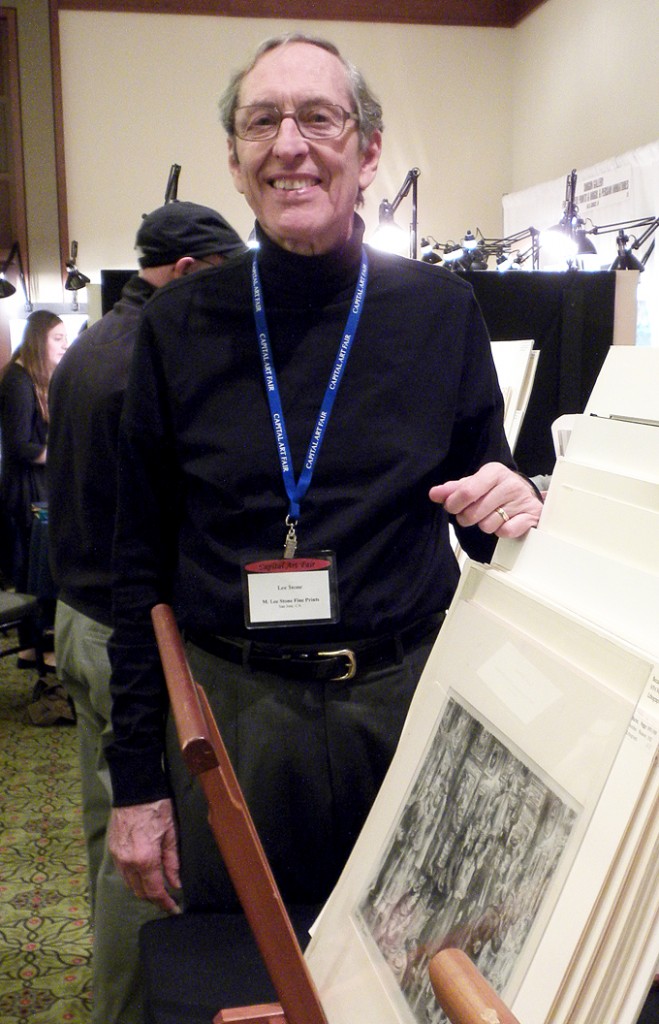
Are you a collector yourself?
YES.
Is it separate from the material you sell?
YES
Or did becoming a print dealer change or stop your collecting?
I didn’t stop; however, as I am getting older, I am now beginning to put some of my collection into my inventory. I still purchase something that I feel I “must have.”
How many shows do you do a year?
4 to 5
What percentage of your sales happen at shows?
About 30% via your website? About 50% via mailings? About 20% [at shows]. These are rough figures as I don’t keep accurate account of these sales.
What are the ways that you obtain your inventory?
I purchase from collectors, occasionally, but less, from auctions, and I do represent a number of artists and artist’s estates.
If you handle estates or deal directly with artists, how did these situations occur?
Word of mouth, friends who knew the artist and recommended me, or I would pursue an artist that I thought I could help and whose work I liked.
Can you give me a short anecdote or two about your life as a print dealer–for instance some incident with a collector or artist?
Some collectors are so insistent that everything about the print should be perfect. I had a very rare American print from 1939. A fabulous image with large margins. The upper right margin, about 2 inches from the image, had at some time been creased. The collector sent the image back because of that. No problem for me as I turned around and sold it for more $$. He called back and changed his mind, and now he wanted it back. Sorrrrrry it was sold. That was a lesson he learned the hard way.
Another collector was very interested in a print at my booth early in the course of a print fair. I have known him for over 15 years and he is a fine collector. He never told me to put a hold on it, and so it remained in my rack. A lady I had never met came by and picked up the print an was fascinated with the subject. While she held the print, my collector comes up behind her, and I could see he wanted that print. However in less than three minutes she says she wants to purchase this print. My collectors mouth dropped, and he was shaken. I later told him all he had to do was tell me to hold the print for an hour or so and he could have had that image. Another lesson learned.
Steve Thomas
Steven Thomas, Inc.
www.woodblock-prints.com
How long have you considered yourself a print dealer, and how did you get your start in the profession?
I have been a print dealer for just under 30 years. I began dealing in antiques when I met my now wife, Deborah, in 1979. I somewhat naively asked her if I could buy this object here, drive up the road and sell it there. Basically true. Loving travel (and her!), I was hooked. I found myself gravitating toward artwork, but having little money, I felt that prints–which few people seemed to know about–might offer me an edge. Since there were no books to look prints up, I began buying dealer catalogs–Childs, Harbor Gallery, June 1 Gallery, etc.–and studying them. I was lucky to have Dartmouth College [near by] and their excellent art library, so I became a “library rat.” I bought every print I could find that was listed in Mallett’s Index of Artistic Biography (and that I could afford). I began advertising for prints—especially woodblock prints which I had an affinity for. In 1986 I was able to buy a grouping of over 40 Margaret Patterson prints which resulted in a show and the first catalogued retrospective of the artist’s work later that year.
Was print dealing your initial profession? If not, what were your earlier jobs or what college training did you have?
I studied psychology and graduated with honors from Lafayette College in 1971. My only art course consisted of looking at slides of famous paintings. A typical question the rigid professor asked to assess one’s knowledge and appreciation of art was: How many people are holding parasols in Suerat’s A Sunday Afternoon of the Island of La Grande Jatte? No help there.
Before getting into the print business, I wrote for many years, published a lot of magazine articles and published two books, one of which is still in print. I was not making a living. When I me Deborah and the art world beckoned, I jumped at it.
Are you a collector yourself?
I’m not a collector. I have stashed collections of obscure printmakers, but I will sell them someday, perhaps after cataloging their work.
How many shows do you do a year? What percentage of your sales happen at shows? Via your website? Via mailings?
Right now, my only “pure” print fair is the Capital Art Fair in D.C., although myself and a small group of dealers are working on a show in November in New York to coincide with the IFPDA Print Fair. My wife and I also do about 6-8 antiques shows where I bring prints (see my website under “Shows”), and I bring about 100 color woodblock prints to the Asheville, NC, Arts & Crafts Show every February.
My sales are roughly equal between shows, my website and my yearly catalog which I issue in September.
What are the ways that you obtain your inventory?
I get my inventory the way everyone does: shows, auctions, advertising.
Trackback URL: https://www.scottponemone.com/print-dealers-where-would-i-be-without-them/trackback/

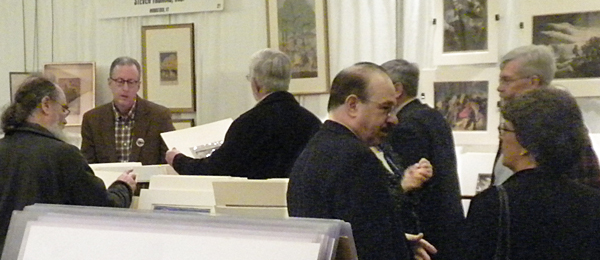
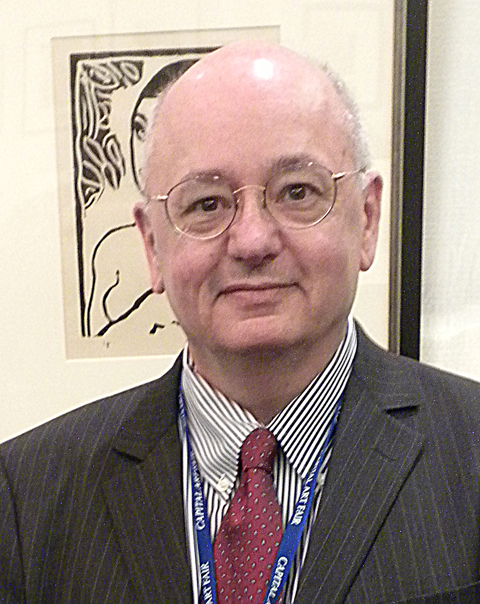
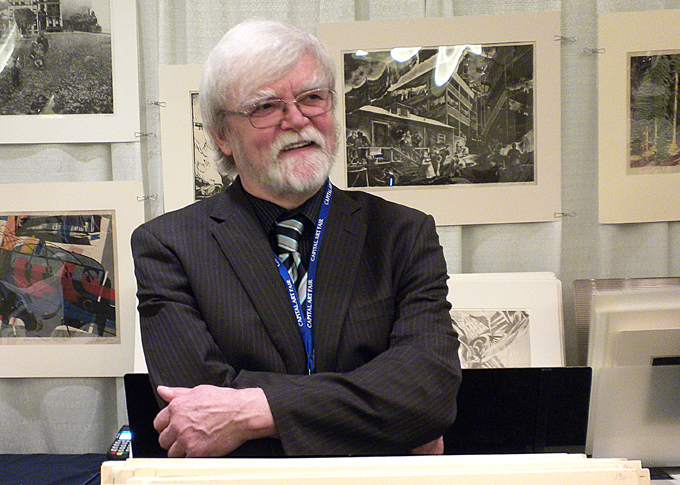
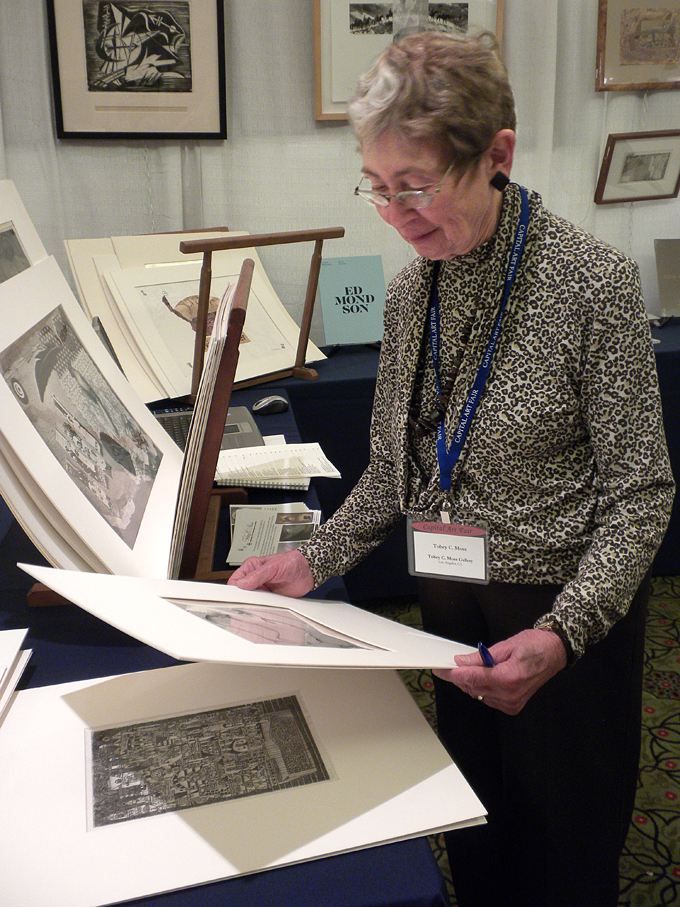
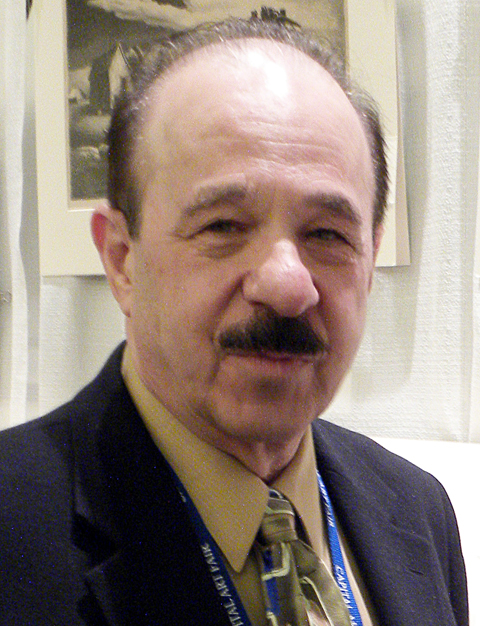
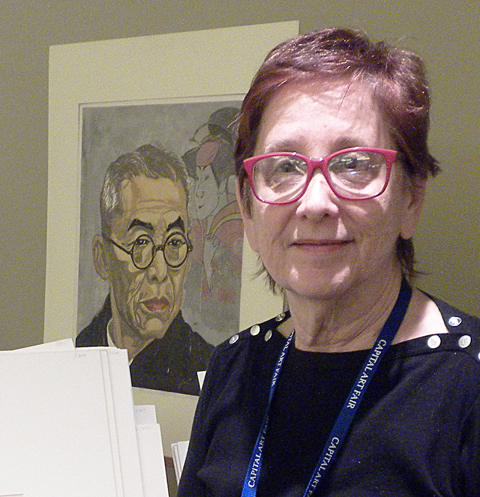











My husband and I are members of the PDPS Friends Group (BMA). I found this article
fascinating, and hope to follow up with these dealers, at least those with websites, and
perhaps visit the Art Fair in DC.
Thank you
Joan Sills